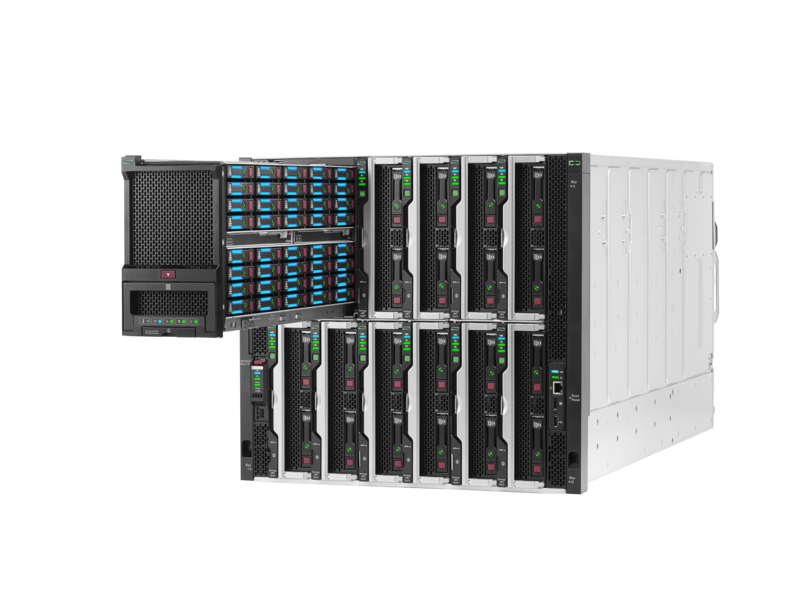
I had the privilege recently to work with a customer who had asked HPE to perform some performance benchmarks not just with HCI Bench, but because they run quite a lot of Oracle workloads they wanted to determine if the performance of vSAN on HPe Synergy would be sufficient in order to run their workloads.
Whilst agreeing on the hardware specification, the customer had referenced my previous post on Optane™ Performance and had asked HPE to perform the tests using Optane™ as the cache tier in the Synergy configuration, this was not only to provide a superior performance experience, but it also would free up two capacity slots in the disk tray of the chassis per Synergy compute node meaning the customer could have more capacity.
Synergy Specification:
- HPE Virtual Connect SE 40Gb F8 Module for Synergy
- HPE Synergy D3940 Storage Module with SAS expanders
- 3x HPE Synergy 480 Gen10 nodes, each equipped with:
- 2x Intel® Xeon® Gold 6154 CPU @ 3.00GHz
- 2x Intel® Optane™ 750 GB SSD DC P4800X Series PCIe (x4)
- 768 GB Memory (24x 32 GB RDIMM @ 2666 MHz)
- 2x Disk Group config with 1x Optane + 3x 800GB SAS per Disk Group
- LACP based 40GbE interconnection between Compute Nodes
Please note: At the time of writing the 750GB U.2 Optane drives were undergoing certification for HPE Synergy.
In order to perform the Oracle workload testing HPE engaged with their own internal Oracle specialists to determine the correct workloads that needed to be performed, and with a target of <2ms specified by the customer they decided to use Kevin Closson’s SLOB tool, SLOB was configured in the following way:
- 128 SLOB Schemas
- Each Schema was 8GB in Size
- Total of 1TB Test data
For the purpose of testing HPE decided that they would perform different tests in the following way:
- (A) Single Oracle VM Instance with 128 Schemas, 70% Read, 30% Write
- (B) Single Oracle VM Instance with 128 Schemas, 50% Read, 50% Write
- (C&D) Single Oracle VM Instance with Heavy REDO activity and Large SGA and REDO_STRESS=Heavy, 50% Read, 50% Write, with 128 Schemas and 32 Schemas
- (E) Single Oracle VM Instance
- (F & G) 2 Parallel Oracle VM Instances with 64 / 128 Schemas Each, 70% Read, 30% Write
| Test | SGA | PGA | Schemas | Scale | REDO_STRESS |
| A | 5G | 1G | 128 | 8G | Lite |
| B | 5G | 1G | 128 | 8G | Lite |
| C | 256G | 100G | 128 | 8G | Heavy |
| D | 256G | 100G | 32 | 8G | Heavy |
| E | 5G | 1G | 128 | 8G | Lite |
| F | 5G | 1G | 64 | 8G | Lite |
| G | 5G | 1G | 128 | 8G | Lite |
Before the tests were performed, and Oracle I/O Calibration was performed which is a feature of Oracle Databases and is used to assess the performance of the I/O subsystem by issuing an I/O intensive read-only workload in order to determine the maximum IOPS and throughput whilst maintaining close to 0ms latency.

Each test ran for 60 minutes in order to ensure enough data was filling up the write buffer, so let’s take a look at the results:



As you can see from the results, the target of <2ms was achieved successfully and at one point with two oracle VMs achieveing a staggering 250k IOPS at 1.305ms latency is very impressive across a 3-Node cluster, not only was the customer pleased with the results, but the Oracle Specialist within HPE said that the results exceeded their expectations also.
So as you can see, a composable infrastructure deployment of vSAN such as HPE Synergy with Intel Optane™ can still deliver the same levels of performance as standard rack mount servers, combined with VMware Cloud Foundation delivering a full SDDC package from both a hardware and software perspective.
